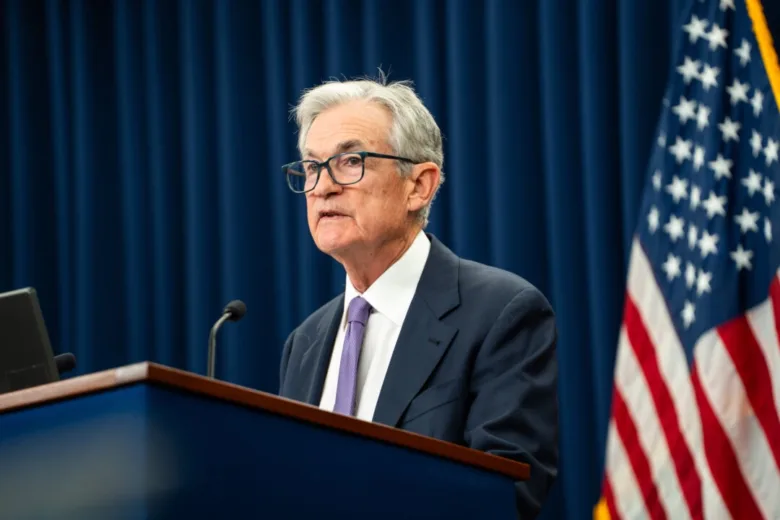By Andrew Moran
The Federal Reserve cut interest rates for the second straight meeting on Oct. 29 as policymakers take a cautious approach to easing monetary policy.
Officials voted to lower the benchmark federal funds rate—a key rate that influences borrowing costs for consumers and businesses—by a quarter point to a new target range of 3.75 percent to 4.00 percent.
“Available indicators suggest that economic activity has been expanding at a moderate pace,” the Federal Open Market Committee said in a post-meeting statement.
“Job gains have slowed this year, and the unemployment rate has edged up but remained low through August; more recent indicators are consistent with these developments. Inflation has moved up since earlier in the year and remains somewhat elevated.”
The Fed also announced it will conclude its balance sheet drawdown on Dec. 1, and begin reinvesting mortgage-backed securities principal payments into treasury bills, or T-bills—short-term securities with maturities of one month to one year.
The committee voted 10–2 for a quarter-point cut. Fed Gov. Stephen Miran preferred a half-point reduction, while Kansas City Fed President Jeffrey Schmid did not want to change the policy rate.
Prior to the meeting, investors had penciled in a 98 percent chance of a 25-basis-point reduction, according to the CME FedWatch Tool.
U.S. stocks had rallied in the days leading up to the October Federal Open Market Committee meeting, with major indexes reaching record highs.
However, markets turned lower after Federal Reserve Chair Jerome Powell signaled at his post-meeting news conference that another rate cut may not happen in December.
“There were strongly different views about how to proceed in December. A further reduction in the policy rate at the December meeting is not a foregone conclusion. Far from it,” Powell said.
The blue-chip Dow Jones Industrial Average reversed its gains during Powell’s press conference, closing down 74.37 points, due to uncertainty about the Fed’s December decision.
‘Much Lower, Much Sooner’
Despite the U.S. central bank being fully engaged in its easing cycle, President Donald Trump and his administration have been pushing for more aggressive rate cuts at an earlier stage.
Trump repeated his criticisms of Powell during his trip to Asia.
“He should have been much lower, much sooner,” the president told reporters aboard Air Force One on Oct. 27.
Later, in a speech to Asian business leaders in South Korea, Trump again called the central bank chief “Jerome ‘Too Late’ Powell.”
“We’re not going to have a Fed that’s going to raise interest rates because they’re worried about inflation in three years from now,” Trump said on Oct. 29.
He also stated that his administration will appoint someone to the Fed “that we all like,” adding that the individual will support lower interest rates.
Treasury Secretary Scott Bessent confirmed to reporters earlier this week that the process to find Powell’s successor has been narrowed to five candidates.
“We’re going to do a second round, and we hope to present a good slate to the president right after Thanksgiving. It will ultimately be his choice,” Bessent told reporters.
The final decision, he noted, will be made before Christmas.
In the meantime, Miran has been advocating for an accelerated push to a neutral level, meaning interest rates neither stimulate nor restrict economic activity. He has wanted half-point rate cuts.
“I think it becomes even more urgent that we get to a more neutral place in policy quickly as opposed to sort of waiting for downside data to materialize,” Miran said at a CNBC event on Oct. 15.
Others have expressed support for a gradual unwinding of tight policies.
Fed Gov. Christopher Waller, considered a top candidate to replace Powell next year, thinks interest rates should be about 100 to 125 basis points lower than they are today.
Waller has dismissed tariff-driven inflation, noting that the administration’s levies have had “modest effects on inflation.” Instead, he will be examining “how the solid GDP data reconcile with the softening labor market.”
“If GDP growth holds up or accelerates and the labor market accordingly recovers, it might be an indication that policy is less restrictive than I thought and that the pace toward a neutral setting for the policy rate should be slower than I expected at the last FOMC meeting,” Waller said in prepared remarks at a Council on Foreign Relations event earlier this month.
“What I would want to avoid is rekindling inflationary pressure by moving too quickly and squandering the significant progress we have made taming inflation,” he said.
In the September Consumer Price Index report, there were signs that the president’s higher import duties were beginning to modestly affect tariff-sensitive items, such as apparel and new vehicles.
However, the annual inflation rate rose to a cooler-than-expected 3 percent. Core inflation, which strips out the noisy food and energy categories, eased to 3 percent—lower than the consensus estimate.
Minutes from last month’s rate-setting committee meeting revealed that policymakers viewed risks to inflation as diminished or unchanged, but they expressed concerns about a worsening labor market.
“The supply of workers has dropped very, very sharply due to mainly immigration, but also lower labor force participation,” Powell said at the news conference.
Absent key government economic data, officials have been relying on alternative, private-sector data to determine the current state of employment conditions.
Recent numbers suggest employment conditions could be rebounding. In the four weeks ending Oct. 11, private companies created an average of 14,250 new jobs per week, according to payroll processor ADP.
Additionally, the Chicago Fed’s Labor Market Indicators suggest the unemployment rate has barely changed, sitting at 4.35 percent.
Because the central bank views data from sources like the Bureau of Labor Statistics or the Bureau of Economic Analysis as the gold standard, it could be harder for the Fed to craft policies.
The Fed will convene its next two-day policy meeting on Dec. 9.





